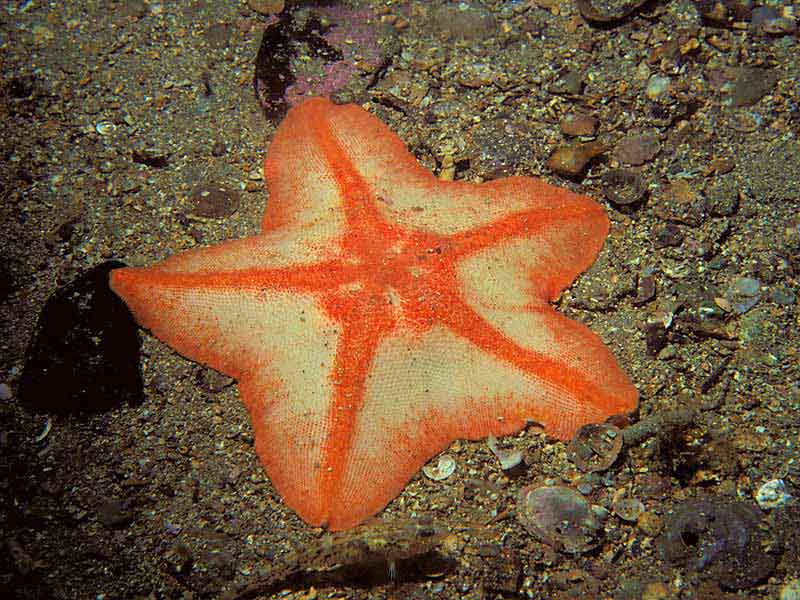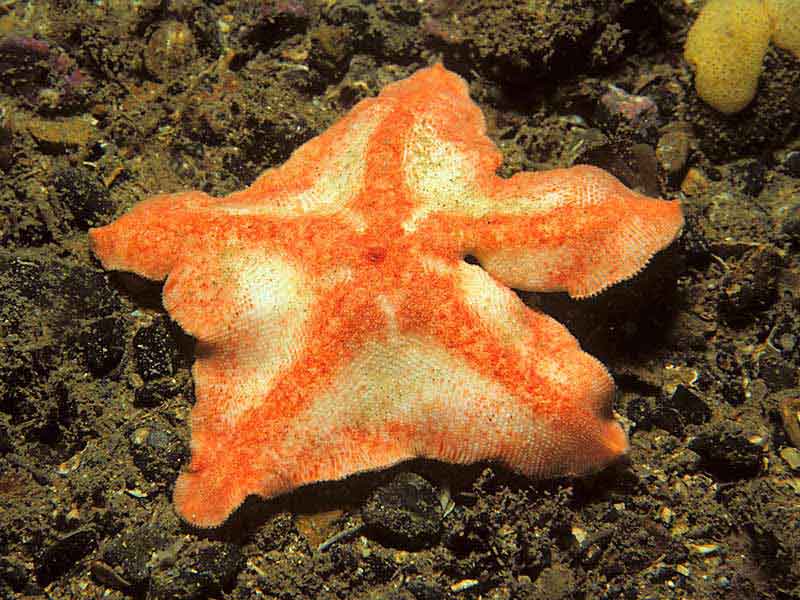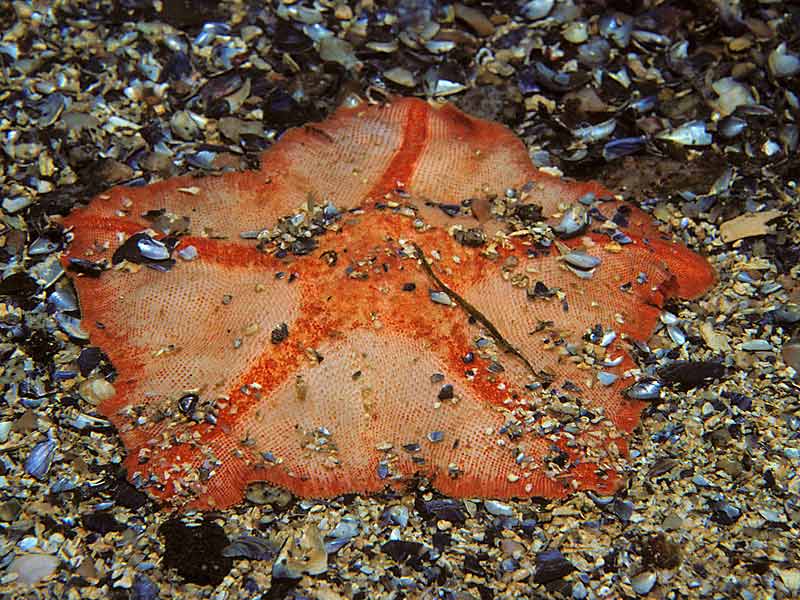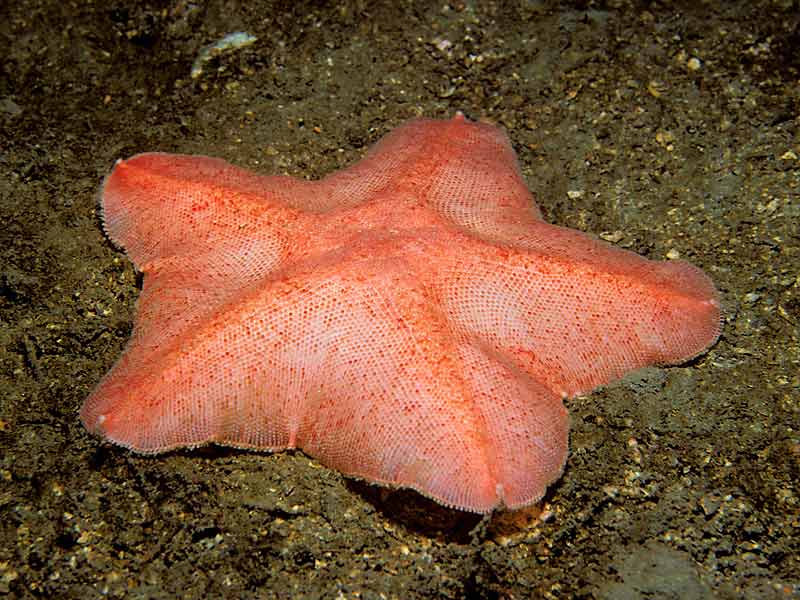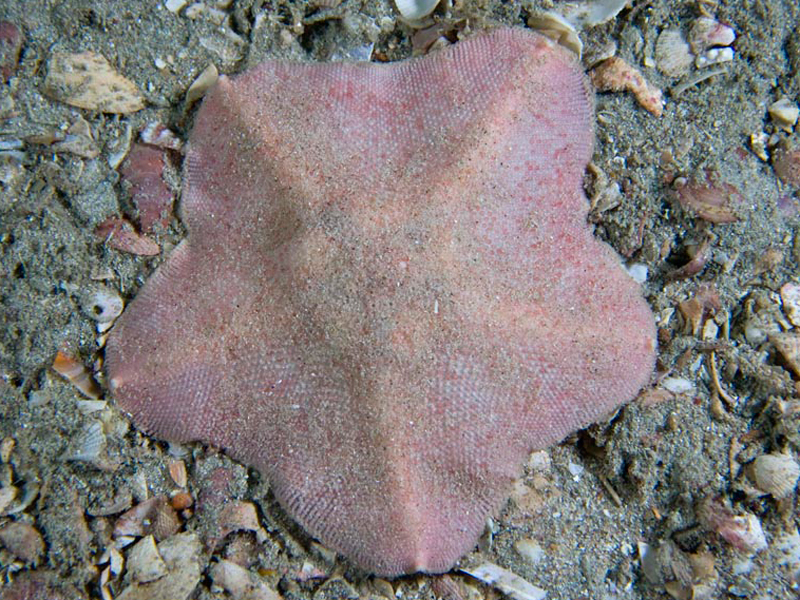Goose foot starfish (Anseropoda placenta)
Distribution data supplied by the Ocean Biodiversity Information System (OBIS). To interrogate UK data visit the NBN Atlas.Map Help
| Researched by | Sonia Rowley | Refereed by | Admin |
| Authority | (Pennant, 1777) | ||
| Other common names | - | Synonyms | Palmipes membranaceus (Pennant, 1777) |
Summary
Description
Recorded distribution in Britain and Ireland
Records extend throughout the British Isles with few records on the east coast. This species may be under recorded.Global distribution
-Habitat
This species occurs subtidally from 10-500 m depth. It can usually be found on or buried in sand with gravel, shell or mud. Smaller individuals may also be found under shells.Depth range
-Identifying features
- Flattened starfish up to 20 cm diameter.
- The five short webbed arms giving pentagonal to sub-pentagonal appearance.
- Covered in fine spines giving granulated texture.
- Dorsally white with red or pink disc and arms.
Additional information
Anseropoda placenta feeds on benthic crustaceans (amphipods, cumaceans, mysids, crabs and hermit crabs), molluscs and echinoderms. This species has no known predators (Mortensen, 1927) and no other similar shallow water species. It breeds in the summer producing large eggs. The copepod Asterocheres siphonatus has been associated with Anseropoda placenta by Gotto (1993, 2004).Listed by
Bibliography
Bruce, J.R., Colman, J.S. & Jones, N.S., 1963. Marine fauna of the Isle of Man. Liverpool: Liverpool University Press.
Costello, M.J., Bouchet, P., Boxshall, G., Emblow, C. & Vanden Berghe, E., 2004. European Register of Marine Species [On-line]. http://www.marbef.org/data/erms.php,
Dipper, R., & Powell. A., 1984. Field guide to the water life of Britain. London: Reader's Digest Association Limited.
Gibson, R., Hextall, B. & Rogers, A., 2001. Photographic guide to the sea and seashore life of Britain and north-west Europe. Oxford: Oxford University Press.
Gotto, V., 1993. Commensal and parasitic copepods associated with marine invertebrates. London: Academic Press. [Synopses of the British Fauna (New Series) No. 46.]
Hayward, P., Nelson-Smith, T. & Shields, C. 1996. Collins pocket guide. Sea shore of Britain and northern Europe. London: HarperCollins.
Hayward, P.J. & Ryland, J.S. (ed.) 1995b. Handbook of the marine fauna of North-West Europe. Oxford: Oxford University Press.
Howson, C.M. & Picton, B.E., 1997. The species directory of the marine fauna and flora of the British Isles and surrounding seas. Belfast: Ulster Museum. [Ulster Museum publication, no. 276.]
MBA (Marine Biological Association), 1957. Plymouth Marine Fauna. Plymouth: Marine Biological Association of the United Kingdom.
Mortensen, T.H., 1927. Handbook of the echinoderms of the British Isles. London: Humphrey Milford, Oxford University Press.
Picton, B.E., 1993. A field guide to the shallow-water echinoderms of the British Isles. London: Immel Publishing Ltd.
Southward, E.C. & Campbell, A.C., 2006. Echinoderms. The Linnean Society of London. Avon: The Bath Press. [Synopses of the British Fauna No. 56.]
Datasets
Cofnod – North Wales Environmental Information Service, 2018. Miscellaneous records held on the Cofnod database. Occurrence dataset: https://doi.org/10.15468/hcgqsi accessed via GBIF.org on 2018-09-25.
NBN (National Biodiversity Network) Atlas. Available from: https://www.nbnatlas.org.
OBIS (Ocean Biodiversity Information System), 2025. Global map of species distribution using gridded data. Available from: Ocean Biogeographic Information System. www.iobis.org. Accessed: 2025-07-27
Citation
This review can be cited as:
Last Updated: 25/01/2007


